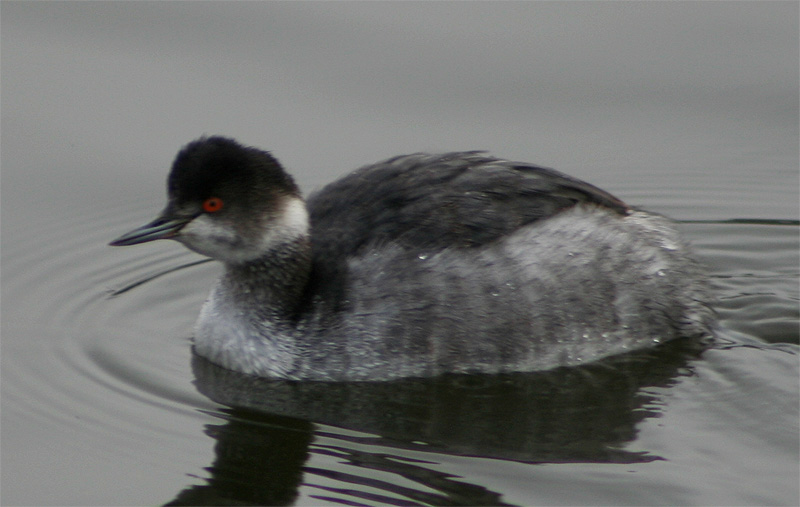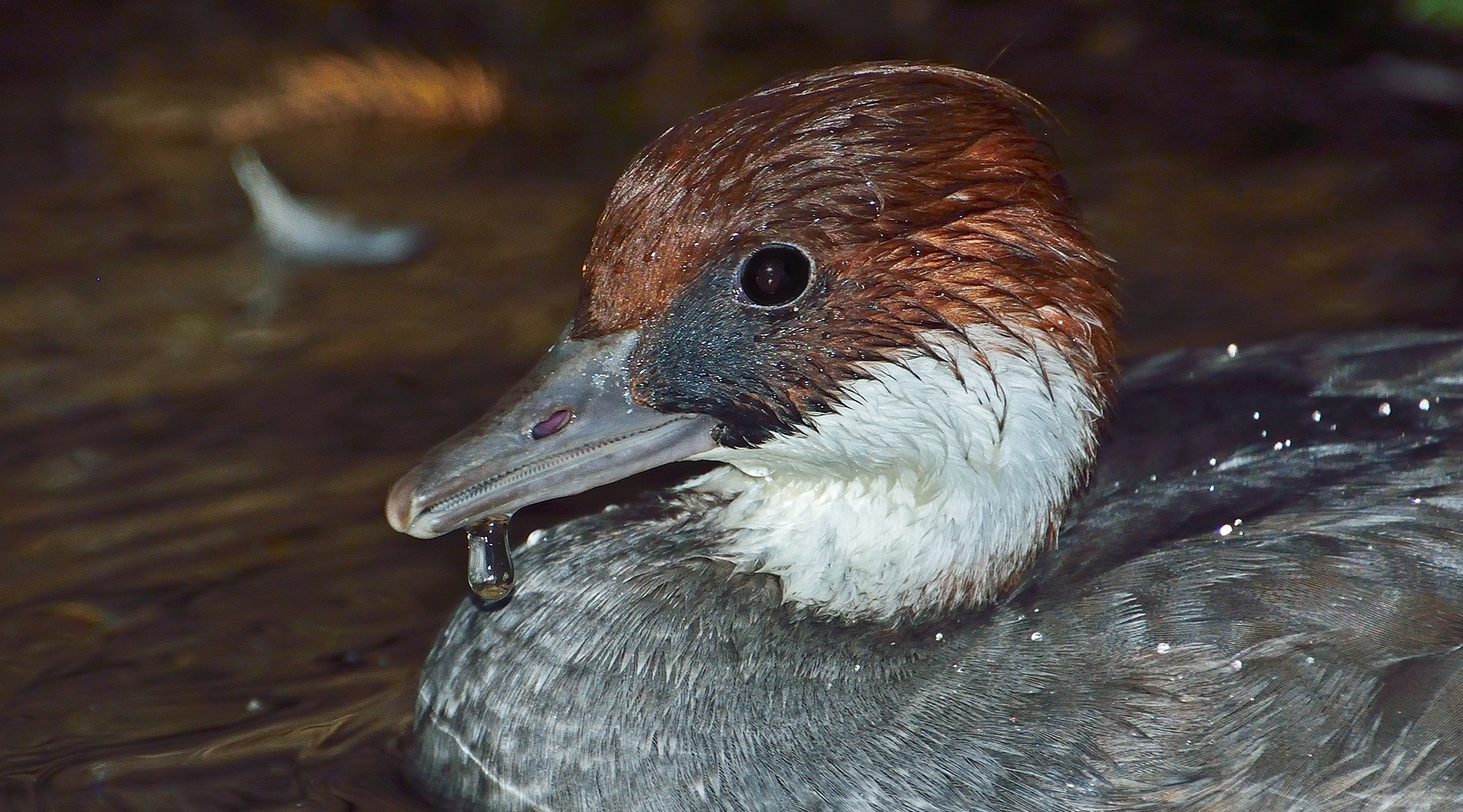|
Blake's Pools
Blake's Pools are a 4 hectare nature reserve owned by Environment Agency and leased by the Avon Wildlife Trust, on the banks of the Congresbury Yeo close to its mouth, near Kingston Seymour, Somerset, in South West England. The three freshwater and brackish pools were dug between 1983 and 1987 to attract wildlife. It forms part of the Severn Estuary Site of Special Scientific Interest, Special Protection Area and Ramsar site. In spring 2001 part of the sea wall protecting the outer pool collapsed, creating a tidal lagoon. To control water levels, sluice gates have been fitted into the two shallow pools. Reeds have also been planted around the largest pool. Over 100 species of bird have visited the reserve, and shelduck, redshank and lapwing often nest. During periods of low tide the expansive areas of mud attract birds such as the little grebe and little egret. The two shallower pools attract wading birds, especially green and common sandpipers. In winter, and variety of wildfow ... [...More Info...] [...Related Items...] OR: [Wikipedia] [Google] [Baidu] |
Tidal Flood Overspill Pond, River Yeo (geograph 4634453)
{{disambiguation ...
Tidal is the adjectival form of tide. Tidal may also refer to: * ''Tidal'' (album), a 1996 album by Fiona Apple * Tidal (king), a king involved in the Battle of the Vale of Siddim * TidalCycles, a live coding environment for music * Tidal (service), a music streaming service * Tidal, Manitoba, Canada ** Tidal station, Tidal, Manitoba See also * Tidal flow (traffic), the flow of traffic thought of as an analogy with the flow of tides * Tidal force, a secondary effect of the force of gravity and is responsible for the tides * Tide (other) A tide is the rise and fall of a sea level caused by the Moon's gravity and other factors. Tide may also refer to: Media * The Tide (Nigeria), ''The Tide'' (Nigeria), a newspaper *Tide (TV series), ''Tide'' (TV series), 2019 Irish/Welsh/Scottish ... [...More Info...] [...Related Items...] OR: [Wikipedia] [Google] [Baidu] |
Common Shelduck
The common shelduck (''Tadorna tadorna'') is a waterfowl species of the shelduck genus, ''Tadorna''. It is widespread and common in the Euro-Siberian region of the Palearctic, mainly breeding in temperate and wintering in subtropical regions; in winter, it can also be found in the Maghreb. Fossil bones from Dorkovo (Bulgaria) described as ''Balcanas pliocaenica'' may actually belong to this species. More likely, they are an extinct species of ''Tadorna'' (if not a distinct genus) due to their Early Pliocene age; the present species is not unequivocally attested from the fossil record until some 2–3 million years later (Late Pliocene/ Early Pleistocene). Taxonomy The common shelduck was formally named by the Swedish naturalist Carl Linnaeus in 1758 in the tenth edition of his '' Systema Naturae'' under the binomial name ''Anas tadorna''. Linnaeus largely based his description on "The Sheldrake or Burrough-Duck" that had been described and illustrated in 1731 by the English ... [...More Info...] [...Related Items...] OR: [Wikipedia] [Google] [Baidu] |
Black-necked Grebe
The black-necked grebe or eared grebe (''Podiceps nigricollis'') is a member of the grebe family of water birds. It was described in 1831 by Christian Ludwig Brehm. There are currently three accepted subspecies, including the nominate subspecies. Its breeding plumage features a distinctive ochre-coloured plumage which extends behind its eye and over its ear coverts. The rest of the upper parts, including the head, neck, and breast, are coloured black to blackish brown. The flanks are tawny rufous to maroon-chestnut, and the abdomen is white. When in its non-breeding plumage, this bird has greyish-black upper parts, including the top of the head and a vertical stripe on the back of the neck. The flanks are also greyish-black. The rest of the body is a white or whitish colour. The juvenile has more brown in its darker areas. The subspecies ''californicus'' can be distinguished from the nominate by the former's usually longer bill. The other subspecies, ''P. n. gurneyi'', can be dif ... [...More Info...] [...Related Items...] OR: [Wikipedia] [Google] [Baidu] |
Greater Scaup
The greater scaup (''Aythya marila''), just scaup in Europe or, colloquially, "bluebill" in North America, is a mid-sized diving duck, larger than the closely related lesser scaup. It spends the summer months breeding in Alaska, northern Canada, Siberia, and the northernmost reaches of Europe. During the winter, it migrates south to the coasts of North America, Europe, and Japan. Drake greater scaup are larger and have more rounded heads than the females; they have a bright blue bill and yellow eyes. Their heads are dark, with a green gloss; the breast is black, the belly white and the wing shows a white stripe. The females are mostly brown, again with white on the wing. They have dull blue bills and white on the face. Greater scaup nest near water, typically on islands in northern lakes or on floating mats of vegetation. They begin breeding at age two, but start building nests in the first year. The drakes have a complex courtship, which takes place on the return migration to ... [...More Info...] [...Related Items...] OR: [Wikipedia] [Google] [Baidu] |
Smew
The smew (''Mergellus albellus'') is a species of duck, and is the only living member of the genus ''Mergellus''. ''Mergellus'' is a diminutive of '' Mergus'' and ''albellus'' is from Latin ''albus'' "white". This genus is closely related to ''Mergus'' and is sometimes included in it, though it might be closer to the goldeneyes (''Bucephala''). The smew has hybridized with the common goldeneye (''B. clangula''). A seaduck fossil from the Middle Miocene shows that birds similar to smew existed up to 13 million years ago. The extant species dates back to the Late Pleistocene. Name The term ''smew'' has been used since the 17th century and is of uncertain origin. It is believed to be related to the Dutch ''smient'' ("wigeon") and the German ''Schmeiente'' or '' Schmünte'', "wild duck." It is probably derived from ''smee'', a dialectal term for a wild duck. Description The drake smew, with its 'cracked ice' or 'panda' appearance, is unmistakable, and looks very black-and- ... [...More Info...] [...Related Items...] OR: [Wikipedia] [Google] [Baidu] |
Common Sandpiper
The common sandpiper (''Actitis hypoleucos'') is a small Palearctic wader. This bird and its American sister species, the spotted sandpiper (''A. macularia''), make up the genus ''Actitis''. They are parapatric and replace each other geographically; stray birds of either species may settle down with breeders of the other and hybridize. Hybridization has also been reported between the common sandpiper and the green sandpiper, a basal species of the closely related shank genus ''Tringa''. Taxonomy The common sandpiper was formally described by the Swedish naturalist Carl Linnaeus in 1758 in the tenth edition of his '' Systema Naturae'' under the binomial name ''Tringa hypoleucos''. The species is now placed together with the spotted sandpiper in the genus ''Actitis'' that was introduced in 1811 by the German zoologist Johann Karl Wilhelm Illiger. The genus name ''Actitis'' is from Ancient Greek ''aktites'' meaning "coast-dweller" from ''akte'' meaning "coast". The specific ... [...More Info...] [...Related Items...] OR: [Wikipedia] [Google] [Baidu] |
Green Sandpiper
The green sandpiper (''Tringa ochropus'') is a small wader (shorebird) of the Old World. The green sandpiper represents an ancient lineage of the genus ''Tringa''; its only close living relative is the solitary sandpiper (''T. solitaria''). They both have brown wings with little light dots and a delicate but contrasting neck and chest pattern. In addition, both species nest in trees, unlike most other scolopacids. Given its basal position in ''Tringa'', it is fairly unsurprising that suspected cases of hybridisation between this species and the common sandpiper (''A. hypoleucos'') of the sister genus ''Actitis'' have been reported. Taxonomy The green sandpiper was formally described by the Swedish naturalist Carl Linnaeus in 1758 in the tenth edition of his ''Systema Naturae'' under the current binomial name ''Tringa ochropus''. The genus name ''Tringa'' is the New Latin name given to the green sandpiper by Aldrovandus in 1599 based on Ancient Greek ''trungas'', a thrush ... [...More Info...] [...Related Items...] OR: [Wikipedia] [Google] [Baidu] |
Little Grebe
The little grebe (''Tachybaptus ruficollis''), also known as dabchick, is a member of the grebe family of water birds. The genus name is from Ancient Greek ''takhus'' "fast" and ''bapto'' "to sink under". The specific ''ruficollis'' is from Latin ''rufus'' "red" and Modern Latin ''-collis'', "-necked", itself derived from Latin ''collum'' "neck". At in length it is the smallest European member of its family. It is commonly found in open bodies of water across most of its range. Taxonomy The little grebe was described by the German naturalist Peter Simon Pallas in 1764 and given the binomial name ''Colymbus ruficollis''. The tricolored grebe was considered conspecific, with some taxonomic authorities still considering it so. There are six currently-recognized subspecies, separated principally by size and colouration. * ''T. r. ruficollis'' – (Pallas, 1764): nominate, found from Europe and western Russia south to North Africa * ''T. r. iraquensis'' – (Ticehurst, 1923): found ... [...More Info...] [...Related Items...] OR: [Wikipedia] [Google] [Baidu] |
Northern Lapwing
The northern lapwing (''Vanellus vanellus''), also known as the peewit or pewit, tuit or tew-it, green plover, or (in Ireland and Britain) pyewipe or just lapwing, is a bird in the lapwing subfamily. It is common through temperate Eurosiberia. Behaviour It is highly migratory over most of its extensive range, wintering further south as far as North Africa, northern India, Nepal, Bhutan and parts of China. It migrates mainly by day, often in large flocks. Lowland breeders in westernmost areas of Europe are resident. It occasionally is a vagrant to North America, especially after storms, as in the Canadian sightings after storms in December 1927 and in January 1966. It is a wader that breeds on cultivated land and other short vegetation habitats. 3–4 eggs are laid in a ground scrape. The nest and young are defended noisily and aggressively against all intruders, up to and including horses and cattle. In winter, it forms huge flocks on open land, particularly arable land a ... [...More Info...] [...Related Items...] OR: [Wikipedia] [Google] [Baidu] |
Common Redshank
The common redshank or simply redshank (''Tringa totanus'') is a Eurasian wader in the large family Scolopacidae. Taxonomy The common redshank was formally described by the Swedish naturalist Carl Linnaeus in 1758 in the tenth edition of his ''Systema Naturae'' under the binomial name ''Scolopax totanus''. It is now placed with twelve other species in the genus ''Tringa'' that Linnaeus had introduced in 1758. The genus name ''Tringa'' is the New Latin name given to the green sandpiper by the Italian naturalist Ulisse Aldrovandi in 1603 based on Ancient Greek ''trungas'', a thrush-sized, white-rumped, tail-bobbing wading bird mentioned by Aristotle. The specific ''totanus'' is from , the Italian name for this bird. Six subspecies are recognised: * ''T. t. robusta'' ( Schiøler, 1919) – breeds in Iceland and the Faroe Islands; non-breeding around the British Isles and west Europe * ''T. t. totanus'' (Linnaeus, 1758) – breeds in west, north Europe to west Siberia; winters in ... [...More Info...] [...Related Items...] OR: [Wikipedia] [Google] [Baidu] |
Ramsar Site
A Ramsar site is a wetland site designated to be of international importance under the Ramsar Convention,8 ha (O) *** Permanent 8 ha (P) *** Seasonal Intermittent < 8 ha(Ts) ** es on inorganic soils: *** Permanent (herb dominated) (Tp) *** Permanent / Seasonal / Intermittent (shrub dominated)(W) *** Permanent / Seasonal / Intermittent (tree dominated) (Xf) *** Seasonal/intermittent (herb dominated) (Ts) ** Marshes on soils: *** Permanent (non-forested)(U) *** Permanent (forested)(Xp) ** Marshes on inorganic or peat soils: *** Marshes on inorganic or peat soils / High altitude (alpine) (Va) *** Marshes on inorganic or peat soils / Tundra (Vt) * Saline, |
.jpg)





